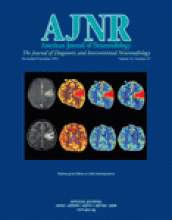Arteriovenous malformations (AVMs) of the brain are fascinating lesions that produce a variety of anatomic and physiologic changes. Many of these features are detectable by MR imaging techniques. The neuroradiologist’s toolbox includes cross-sectional imaging, time-of-flight MR angiography (MRA), phase contrast flow measurements, functional MR imaging, diffusion tensor imaging, and perfusion imaging. An emerging technology is the combination of 3D MRA vascular models with computational fluid dynamics. This approach generates computer simulations of flow for a specific patient’s vascular geometry.
Stereotactic radiosurgery is a widely accepted treatment for AVMs that cannot be removed by microsurgical techniques. Radiosurgery has a 2-year obliteration rate of approximately 87% for AVMs less the 4 cm3 in volume. Larger AVMs may be successfully treated by a combination of embolization and radiosurgery.
In this issue of the AJNR, Guo et al describe the perfusion characteristics of brain tissue adjacent to AVMs before and after radiosurgery. The authors present examples of reversible perfusion defects and conclude that the regions of hypoperfusion on pretreatment studies are due to a steal phenomenon. Elegant evaluations of AVMs by using positron emission tomography (1) and in vivo measurements of arterial pressure (2) only weakly substantiate the widely held opinion that alterations in regional perfusion are the result of hemodynamic failure and loss of autoregulation.
In addition to altered hemodynamics, AVMs affect neighboring brain tissue by diachisis-like cortical depression from neuronal deafferentation. The result is reduced perfusion to the depressed cortex. Other causes of reduced perfusion include venous hypertension, mass effect, radiation injury, and edema. Slow-growing AVMs also allow the brain to reorganize with translocation of eloquent brain functions to other cortical regions, thus reducing the metabolic demand for flow near the AVM (3). Regional perfusion may increase because of alterations in nitric oxide signaling, the release of angiogenesis factors, or prolonged seizure activity.
The authors clearly demonstrate that brain perfusion is highly variable in regions surrounding AVMs. Brain tissue adjacent to AVMs may have 1) normal perfusion, normal autoregulation; 2) normal perfusion, maximized vasodilatation, increased cerebral blood volume (CBV), and exhausted flow reserve; or 3) chronic reduced perfusion with blunted autoregulation.
The authors report that a fourth condition exits in which flow is increased in brain tissue adjacent to the AVM. In their Table 1, the authors list five patients of 19 with type I patterns (increase perfusion in both immediate and remote surroundings) and nine patients with type II patterns (increased perfusion in immediate surroundings and decreased perfusion in remote surroundings). This observation is truly interesting. What is the underlying biology of this increase in flow adjacent to the AVM nidus in 14 of the 19 reported cases? Is this a manifestation of increased capillary density due to the release of vascular endothelial growth factor A, which is know to be elevated in patients with AVMs? Or is this increase in perfusion an effect of excess angiogenesis gene expression such as the proangiogenesis Hox D3 gene, resulting in poor regulation of capillary proliferation? It would very valuable if CBV could be used as a surrogate for angiogenesis. There is some evidence that this may be the case. For example, CBV is often markedly elevated in high-grade gliomas. These neoplasms also have highly activated angiogenesis systems with prominent neovascularity.
One final thought. Does increased perfusion adjacent to the AVMs have any relation to the phenomenon of post-AVM resection normal perfusion pressure breakthrough (also termed “arterial-capillary-venous hypertension syndrome”)? This poorly understood condition appears to be a combination of increased permeability of endothelial cells, friable vascular malformation remnants at the edge of the resection, or propagation of venous occlusive syndromes (4). Is it possible that the regions of increased perfusion as reported by Guo et al represent a transition zone wherein the metabolic effects of angiogenesis renders the brain vulnerable to postresection edema and hemorrhage?
The report contains several interesting observations regarding the complex nature of perfusion alterations related to AVMs. I would encourage the reader to consider the multitude of events that occur in the vicinity of an AVM and to not attribute the findings entirely to a steal phenomenon. In addition, a more complete characterization of the perinidal perfusion will be needed to determine whether the perfusion increase is a valuable new observation or an epiphenomenon of limited clinical importance.
- Copyright © American Society of Neuroradiology












